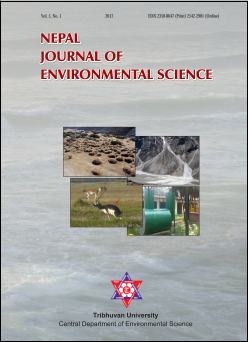Biogas production for organic waste management: a case study of canteen’s organic waste in Solid Waste Management Technical Support Center, Lalitpur, Nepal
DOI:
https://doi.org/10.3126/njes.v5i0.22714Keywords:
Bio-slurry, CO2 reduction, fertilizer, methane, urban biogas plantAbstract
Management of solid waste is one of the major challenges faced by the municipalities. Solid waste mainly comprises of organic waste. Proper management of organic waste helps minimize solid waste problem. This study was carried out to assess the production of biogas from canteen’s organic waste as a solution for management of organic waste in Solid Waste Management Technical Support Centre, Lalitpur using innovative urban biogas plant with capacity 1,275 liters for 48 days. The physicochemical parameters of canteen’s waste and bio-slurry were analyzed. Similarly, volume of biogas, volume of methane and carbon dioxide in biogas produced were measured and CO2 reduction from biogas plant was identified. The average values of physicochemical parameters of canteen’s waste lied within the optimum range for biogas production. The biogas plant produced 22.03 liters/kg of waste and 120.47 liters/day of biogas. The produced biogas contained 48.89% methane and 39.11% carbon dioxide on average. The biogas plant could reduce 3.20 tones of CO2 equivalent per annum from 262.50 kg of waste fed for 48 days. The values of nitrogen, phosphorus and potassium of bio-slurry indicated it as a better fertilizer. Shapiro-Wilk test showed that the p-value of collected data were greater than 0.05 indicating normal distribution. Linear regression between ambient temperature and biogas production showed that the p-value less than 0.05 indicating significant relationship between them (r2=0.08). The estimated return period of the invested money was 9.5 months in kerosene substitution or 9.7 months in firewood substitution or 9.5 months in LPG substitution. Similarly, the estimated average rate of return was 125.26% in kerosene substitution or 123.72% in firewood substitution or 125.01% in LPG substitution. These results indicated that biogas production using innovative urban biogas plant is better solution for organic waste management. Further extensive and large scale research need to be carried out for the optimization of the biogas plant.
Downloads
Downloads
Published
How to Cite
Issue
Section
License
This license enables reusers to distribute, remix, adapt, and build upon the material in any medium or format for noncommercial purposes only, and only so long as attribution is given to the creator.




